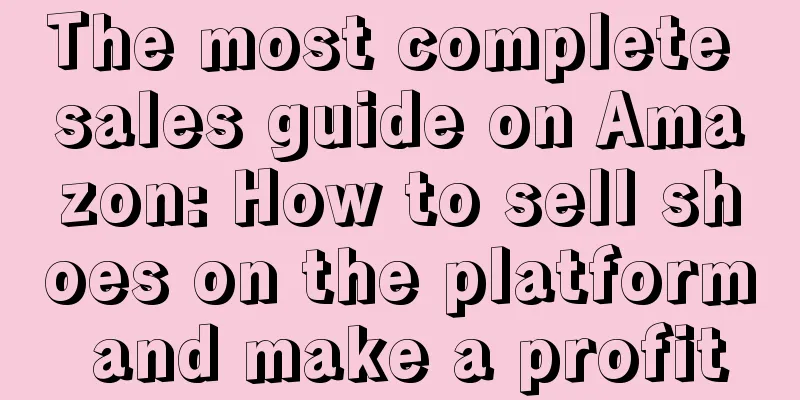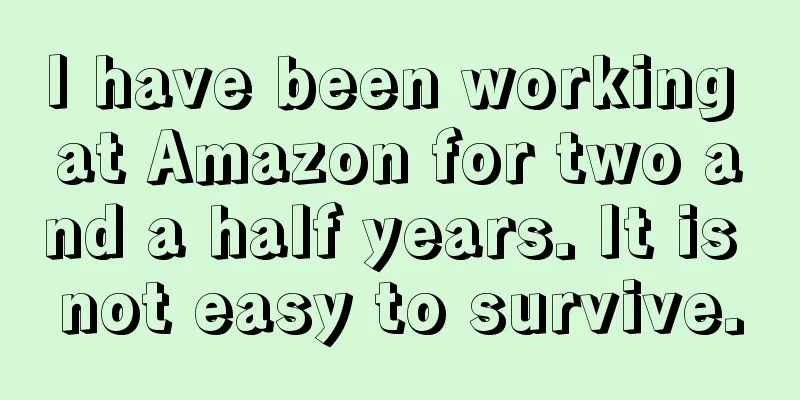The most complete sales guide on Amazon: How to sell shoes on the platform and make a profit

|
Thanks to Amazon, starting an e-commerce business has become much easier. In 2017, Amazon’s total revenue reached $177.9 billion, 15% of which came from best-selling categories, including shoes, clothing, and jewelry. And the company even surpassed Nike to become the top retail destination for men’s shoes. Therefore, it is a good idea to sell shoes on Amazon. But like selling other products, you will find that there are many competitors. But don’t worry, here is the most complete guide to selling shoes on Amazon, from product selection to product listing and optimization, this article may help sellers stand out from many competitors. In order to make your shoes sell well, you have to sell shoes that buyers want to buy, and you can’t just pick a pair of shoes and sell them on Amazon and then sit back and wait for the orders to come in. You have to resell shoes strategically. First, sellers need to check out the Amazon best-selling product page to see the best-selling shoes. At the time of writing this article, the best-selling shoes list is as follows: (1) Reasons why best-selling shoes on Amazon are so popular On Amazon, the best-performing shoes are not from big brands. Why? Because these Amazon best-selling shoes have two main characteristics: seasonality and comfort. Seasonality has a big impact on product sales. Since it’s winter, boots are doing well. Meanwhile, comfort is another important factor. A quick look at the top 4 best-selling men’s shoes shows that two pairs have soles made of memory foam. When looking at the top 8 best-selling shoes, you'll notice that some have waterproof or quick-drying features. Consumers may prioritize functionality and comfort over style and brand recognition. Of course, there are other factors to consider. Crocs classic clogs do rank high in both men's and women's shoes. Crocs does not meet most of the key factors discussed above. Although it is not a winter product, it does appeal to a user base that seeks comfort. It also bills itself as a casual water shoe that can be worn by both men and women. So, when choosing shoes to sell on Amazon, consider the above two metrics as you browse the Amazon best-selling product list and you’ll have a good idea of the shoes that buyers want and need right now. (2) Check the product price history list Once you’ve figured out what kind of shoes you want to sell, it’s time to find suppliers. Ideally, you can source shoes at a low price and sell them on Amazon for maximum profit. However, manually finding low-priced shoe suppliers can be difficult. Luckily, there are tools you can use to research product pricing, such as: CamelCamelCamel CamelCamelCamel aims to track product pricing and alert you when prices drop. This way, you can buy at the best time. And it can also track prices of wishlist products and track multiple price types. You can just paste the Amazon product URL and get results instantly. Take Crocs, for example. CamelCamelCamel shows how pricing for Crocs has changed since they were first listed on Amazon in 2008. The lowest priced Crocs sold for $13.95, while the highest was $35. When prices drop or rise, the chart alerts you. Keepa Keepa requires you to register an account before tracking Amazon products. In Keepa, you will be able to see pricing information for all similar products. The tool also allows you to access a list of Amazon’s best-selling products, sorted by sales rank. It allows you to get a list of top sellers. You can also set up price increase alerts so that Keepa can notify you when a product reaches a threshold. You need all this data to assess when to raise or lower your prices. By looking at competitor data, you can set competitive prices. You can also keep an eye out for shoes that are coming out or will soon be available. Find out how much those shoes cost and calculate shipping, customs, and other fees. Once you’ve decided which products to sell, it’s time to do Amazon keyword research. Finding the right keywords is important because these keywords will help users find your products when they search for shoes on Amazon. But not all keywords need to be used, just use search keywords with a higher average monthly search volume. Keyword tools like Keyword Tool can help you find the best keywords for your products. Keyword Tool provides you with keyword ideas along with the search volume for each keyword and shows you how competitive the keyword is in Google AdWords. In addition, sellers can also use some tools to conduct in-depth research on product keywords, such as Unicorn Smasher and Jungle Scout. Unicorn Smasher is a powerful Amazon product research tool that can make a great contribution to your footwear business. Like Unicorn Smasher, Jungle Scout can also be used to optimize Amazon pages. It has tools to find niche products, spy on your competitors, and find and manage listing keywords. These two tools are very important for testing whether there is a market for your product. As your business grows, you will need a tool to manage ratings, reviews, opportunity scores, estimated sales, etc. Both of the above tools can help you. Sellers are also advised to apply to become shoe distributors. You need to make a business plan and understand some data in advance, including startup costs, monthly management fees, and workload. Sellers need to determine which shoe brands they want to work with. You need to choose a shoe brand that is suitable for sale on Amazon and has market demand. Sellers can first ask themselves whether they want to focus on sports shoes or potential niche shoes to determine which brands can meet your needs. Then contact suppliers for procurement. To sell products on Amazon, if you register as a professional seller, the monthly fee is $39.99 plus a referral fee. If you use FBA to ship, you will need storage fees and fulfillment fees, etc. Some of the best-selling shoes on Amazon come from restricted brands, which is designed to prevent sellers from selling major brand shoes such as Nike and Under Armour. But if you are keen on selling such shoes, there are ways to do so, such as working with authorized sellers. Here are Amazon's shoe sales policies:
In addition, Amazon released a list of violations:
Once you have everything finished, you can start with your product listing. There are three main things you should focus on: product images, pricing, and product descriptions. (1) Product images You need to be aware of Amazon’s product image requirements. The dimensions should be at least 1000 x 1000 px (square), and the product itself should fill 85% of the image. The background color needs to be white, and it should be saved in JPEG, TIFF, or GIF format and saved in RGB color space. When saving the file, keep in mind that the file name should include the product identifier, which could be an Amazon ASIN, a 13-digit ISBN, an EAN, a JAN, or a UPC. Then the appropriate file extension (such as .jpg or .tif). Amazon will not accept product images that do not comply with its existing file naming guidelines. You may have noticed that Amazon uses a lot of images when showcasing products. Let’s look at the different types of images you can use:
You can also use a graphic version of your brand description, so that you can have a 30-second video in the main image of your product listing. If you have photography experience, you can take product pictures yourself, or you can hire a professional photographer to take pictures. Remember, the better your product pictures are, the more likely buyers are to be interested in your products and buy them. (2) Product Pricing Before you price your shoes, you need to determine all the expenses. You also need to look at your target audience and whether they can afford your shoes. While there is a demand for high-end footwear in the market, it may not be suitable for your target customers. You can check your competitors’ pricing by searching manually or using tools. There is a lot to learn from experienced eCommerce sellers. Pay attention to their every move and pay close attention to their pricing strategies. Prices change over time, so be prepared to adjust your pricing. There are many factors that affect the price of shoes on Amazon. For example, new products are released. This will cause customers to flock to the new products and stop buying the old models. Your pricing strategy should also consider holidays and seasonal sales, which are the best way to understand the market for your products. It is also a good time to reduce the price of shoes and clear out inventory. (3) Write a product description If the product description is well written, the product can also sell better. As mentioned before, it is also important to insert appropriate keywords in the product description. Product description is also one of the important factors that Amazon uses to determine product rankings. Remember, never stuff keywords. Instead, use appropriate keywords and make sure that the product description is written for people to see, not search engines. Since Amazon products also appear on Google, your product descriptions should also be optimized for Google accordingly. Here are some of Amazon’s regulations regarding product listings: 1) Follow the relevant style guidelines for product listings; 2) Do not use HTML, JavaScript, or other types of code in your product detail pages; 3) The following content is not allowed in the product listing title, product description, bullet points, and images:
With FBA, Amazon takes care of packaging, shipping, and delivering the products to customers, so you can focus on increasing sales. So, let’s say you find a particular type of shoe that, based on your product research, sells really well, you can go to a wholesaler, buy it in bulk, and then ship it to an Amazon fulfillment center. Amazon will then pack and ship the shoes for you. You don’t have to ship the order yourself. To start selling products on Amazon, first go to Amazon Services and click Start Selling. You will be prompted to create an account and asked for some basic information as well as your business details and tax information. Once you provide all the details, your registration is complete and you can start creating product listings. In the dashboard, go to Inventory > Add a Product > Create a New Product Listing. The search bar allows you to find a category, in this case shoes. Amazon will return different categories related to your search query, and then choose the category that best suits your product. You will then be taken to a page where you can provide your product information. Fill out the form and sometimes Amazon will ask you to provide a GS1, UPC code. You may also upload product images, add keywords, and insert other relevant product information. Once you are done, click “Save and Finish.” Amazon will then review your listing. *Tips: Before you start selling products on Amazon, there are a few things to keep in mind:
There is a lot of money to be made selling shoes on Amazon. While the process can be intimidating for new sellers, the rewards are huge. As long as you follow some of the tips above, you will be able to profit from reselling shoes. Text✎ Fang Xiaoling/ Statement: When reprinting this article, the title and original text must not be modified, and the source and original link must be retained. |
Recommend
The European and American epidemic is about to break out! Sellers can’t miss this opportunity
It is no exaggeration to say that I think the epi...
Do you know the 14 factors that affect Amazon Listing conversion rate?
We all know how important the Amazon listing conve...
What are negative keywords? Negative keywords evaluation
Negative keywords are a great way for Amazon selle...
The coolest Black Friday data is out! The goods are not ready for delivery, the real culprit is...
▶ Video account attention cross-border navigation ...
What is Payssion? Payssion Review
Payssion is a one-stop global online payment servi...
Etsy releases the latest consumer trends for home improvement in 2022! Popular product recommendations
It is learned that Etsy recently released the late...
Amazon bans accounts on a large scale! A large number of sellers suffer!
Since 2024, Amazon's account sweeping campaign...
Wayfair lays off another 340 employees as it adjusts its business to meet market challenges
It is learned that recently, according to foreign ...
Analysis of various means of malicious dog transformation and recovery methods
Two situations where Amazon listings go haywire R...
Account will be blocked if no operation is performed in 7 days! Amazon has a new verification method? One seller had 150 accounts blocked in 3 days
Starting last year, Amazon has conducted large-sca...
“0” tariffs! “Billions” of business opportunities! RCEP dividends are waiting for you!
RCEP: The world's largest free trade zone is ...
Under the Sino-US trade war, sellers suffered three major blows
The Sino-US trade war has lasted for more than a y...
What is eCRATER? eCRATER Review
eCrater is both a free online store builder and an...
What is SellerActive? SellerActive Review
SellerActive is a multi-platform order management ...
Amazon becomes the most popular retailer, but will it be "sanctioned" by law?
<span data-shimo-docs="[[20,"最近,一个关于亚马逊的新计...









